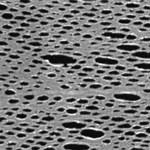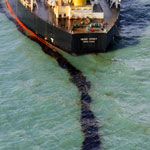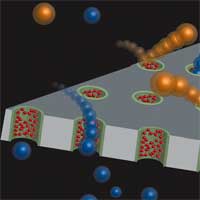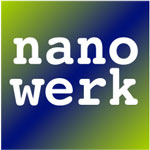Showing Spotlights 17 - 24 of 25 in category All (newest first):
 Delivering healthy proteins directly into human cells to replace malfunctioning proteins is considered one of the most direct and safe approaches for treating diseases. Controlled and long-term protein drug delivery has also been considered as one of the most promising biomedical applications of nanotechnology. So far, though, the effectiveness of protein therapy has been limited by low delivery efficiency and the poor stability of proteins, which are frequently broken down and digested by cells' protease enzymes before they reach their intended target. This not only makes the drugs ineffective, it can also cause unpredictable side effects such as inflammation, toxicity, and immune responses. The best way for the delivery of protein drugs without denaturation might be possible by exploiting the passive diffusion through a membrane without physical and chemical stresses. This can be achieved when pore sizes in a membrane are controlled to satisfy the single-file diffusion condition of protein drugs.
Delivering healthy proteins directly into human cells to replace malfunctioning proteins is considered one of the most direct and safe approaches for treating diseases. Controlled and long-term protein drug delivery has also been considered as one of the most promising biomedical applications of nanotechnology. So far, though, the effectiveness of protein therapy has been limited by low delivery efficiency and the poor stability of proteins, which are frequently broken down and digested by cells' protease enzymes before they reach their intended target. This not only makes the drugs ineffective, it can also cause unpredictable side effects such as inflammation, toxicity, and immune responses. The best way for the delivery of protein drugs without denaturation might be possible by exploiting the passive diffusion through a membrane without physical and chemical stresses. This can be achieved when pore sizes in a membrane are controlled to satisfy the single-file diffusion condition of protein drugs.
Aug 10th, 2010
 Ultrathin nanosieves with a thickness smaller than the size of the pores are especially advantageous for applications in materials separation since they result in an increase of flow across the nanosieve. Separation of complex biological fluids can particularly benefit from novel, chemically functionalized nanosieves, since many bioanalytical problems in proteomics or medical diagnostics cannot be solved with conventional separation technologies. Researchers in Germany have now fabricated chemically functionalized nanosieves with a thickness of only 1 nm - the thinnest free-standing nanosieve membranes that have been reported so far. The size of the nanoholes in the membranes can be flexibly adjusted down to 30 nm by choosing appropriate conditions for lithography.
Ultrathin nanosieves with a thickness smaller than the size of the pores are especially advantageous for applications in materials separation since they result in an increase of flow across the nanosieve. Separation of complex biological fluids can particularly benefit from novel, chemically functionalized nanosieves, since many bioanalytical problems in proteomics or medical diagnostics cannot be solved with conventional separation technologies. Researchers in Germany have now fabricated chemically functionalized nanosieves with a thickness of only 1 nm - the thinnest free-standing nanosieve membranes that have been reported so far. The size of the nanoholes in the membranes can be flexibly adjusted down to 30 nm by choosing appropriate conditions for lithography.
Dec 9th, 2009
 Advanced material engineering techniques can structure surfaces that allow dynamic tuning of their wettability all the way from superhydrophobic (i.e. repelling) behavior to almost complete wetting (i.e. superhydrophilic or strongly absorbing) - but these surfaces only work with high-surface-tension liquids. Almost all organic liquids that are ubiquitous in human environment such as oils, solvents, detergents, etc. have fairly low surface tensions and thus readily wet even superhydrophobic surfaces. In a previous Spotlight we reported how researchers have been creating surfaces that would extend superhydrophobic behavior to all liquids, no matter what the surface tension. New work coming out of MIT now describes a novel nanostructures membrane that can be switched between superhydrophilic and superhydrophobic behavior on demand. Think of it as an 'oil spill clean-up paper towel' that absorbs only the oil but not the water. Given the global scale of severe water pollution arising from oil spills and industrial organic pollutants, this nanomaterial may prove particularly useful in the design of recyclable absorbents with significant environmental impact.
Advanced material engineering techniques can structure surfaces that allow dynamic tuning of their wettability all the way from superhydrophobic (i.e. repelling) behavior to almost complete wetting (i.e. superhydrophilic or strongly absorbing) - but these surfaces only work with high-surface-tension liquids. Almost all organic liquids that are ubiquitous in human environment such as oils, solvents, detergents, etc. have fairly low surface tensions and thus readily wet even superhydrophobic surfaces. In a previous Spotlight we reported how researchers have been creating surfaces that would extend superhydrophobic behavior to all liquids, no matter what the surface tension. New work coming out of MIT now describes a novel nanostructures membrane that can be switched between superhydrophilic and superhydrophobic behavior on demand. Think of it as an 'oil spill clean-up paper towel' that absorbs only the oil but not the water. Given the global scale of severe water pollution arising from oil spills and industrial organic pollutants, this nanomaterial may prove particularly useful in the design of recyclable absorbents with significant environmental impact.
May 30th, 2008
 Separation and purification of bio-molecules such as proteins and viruses are important processes in the biotechnology industry. The risk of contamination with either known or unknown viruses in biological or therapeutic products require production processes that - ideally - completely eliminate the risks of virus contamination. Since the existence of very small amounts of viruses with a size of tens of nanometers causes severe damage to the entire bio-process, the filtration of viruses has to be pretty much perfect. Micro- and ultrafiltration have been successfully used in numerous processes as a robust step for virus reduction but they are not 100% effective. Currently used ultrafiltration membranes still allow smaller-sized virus particles to permeate into a small number of abnormally large-sized pores in the membrane. This broad size distribution of pores in ultrafiltration membranes and the low density of pores in track-etched membranes limit the practical use of virus filtration.
Separation and purification of bio-molecules such as proteins and viruses are important processes in the biotechnology industry. The risk of contamination with either known or unknown viruses in biological or therapeutic products require production processes that - ideally - completely eliminate the risks of virus contamination. Since the existence of very small amounts of viruses with a size of tens of nanometers causes severe damage to the entire bio-process, the filtration of viruses has to be pretty much perfect. Micro- and ultrafiltration have been successfully used in numerous processes as a robust step for virus reduction but they are not 100% effective. Currently used ultrafiltration membranes still allow smaller-sized virus particles to permeate into a small number of abnormally large-sized pores in the membrane. This broad size distribution of pores in ultrafiltration membranes and the low density of pores in track-etched membranes limit the practical use of virus filtration.
May 23rd, 2008
 Nanopores function as membrane channels in all living systems, where they serve as sensitive electro-mechanical devices that regulate electrical potential, ionic flow, and molecular transport through the cell membrane. Scientists are studying nanopore construction with the goal of making man-made cell membranes and single molecule detectors. So far, nanoporous membrane-based separations simply use the difference in size of the analytes relative to pore size in the membrane. Here, for a nanopore to be useful as a single molecule detector, its diameter must not be much larger than the size of the molecule to be detected. When a single molecule enters a nanopore in an insulating membrane, it causes changes in the nanopore's electrical properties, which then can be detected and measured. In order to bring about selectivity beyond size, it is necessary that methods for functionalizing the membrane pores are available. To that end, researchers have developed a very simple, but versatile, method for decorating the nanoporous membranes with functional groups. By uniformly modifying the internal cavities of nanopores with various polymers they were able to demonstrate selectivities based on size, charge and hydrophobicity of the molecule passing through the nanopore.
Nanopores function as membrane channels in all living systems, where they serve as sensitive electro-mechanical devices that regulate electrical potential, ionic flow, and molecular transport through the cell membrane. Scientists are studying nanopore construction with the goal of making man-made cell membranes and single molecule detectors. So far, nanoporous membrane-based separations simply use the difference in size of the analytes relative to pore size in the membrane. Here, for a nanopore to be useful as a single molecule detector, its diameter must not be much larger than the size of the molecule to be detected. When a single molecule enters a nanopore in an insulating membrane, it causes changes in the nanopore's electrical properties, which then can be detected and measured. In order to bring about selectivity beyond size, it is necessary that methods for functionalizing the membrane pores are available. To that end, researchers have developed a very simple, but versatile, method for decorating the nanoporous membranes with functional groups. By uniformly modifying the internal cavities of nanopores with various polymers they were able to demonstrate selectivities based on size, charge and hydrophobicity of the molecule passing through the nanopore.
Feb 6th, 2008
 Researchers in Singapore functionalized a polymer nanofiber membrane to capture chemical warfare agents such as nerve agents. The nanofibers in the membrane act as a substrate on which the nerve agents get physically adsorbed followed by chemical decomposition.
Researchers in Singapore functionalized a polymer nanofiber membrane to capture chemical warfare agents such as nerve agents. The nanofibers in the membrane act as a substrate on which the nerve agents get physically adsorbed followed by chemical decomposition.
Jun 12th, 2006
 Silver single crystals were facilely synthesized on a large-scale with good reproducibility in water at room temperature in the presence of carboxyl-functionalized carbon nanotubes, without any additional reducing agent/electrochemical reducing, microwave, sonication or irradiations.
Silver single crystals were facilely synthesized on a large-scale with good reproducibility in water at room temperature in the presence of carboxyl-functionalized carbon nanotubes, without any additional reducing agent/electrochemical reducing, microwave, sonication or irradiations.
Jun 9th, 2006
 A new method for preparation of a double-layered nanoporous membrane suitable for virus filtration was developed.
A new method for preparation of a double-layered nanoporous membrane suitable for virus filtration was developed.
Mar 28th, 2006
 Delivering healthy proteins directly into human cells to replace malfunctioning proteins is considered one of the most direct and safe approaches for treating diseases. Controlled and long-term protein drug delivery has also been considered as one of the most promising biomedical applications of nanotechnology. So far, though, the effectiveness of protein therapy has been limited by low delivery efficiency and the poor stability of proteins, which are frequently broken down and digested by cells' protease enzymes before they reach their intended target. This not only makes the drugs ineffective, it can also cause unpredictable side effects such as inflammation, toxicity, and immune responses. The best way for the delivery of protein drugs without denaturation might be possible by exploiting the passive diffusion through a membrane without physical and chemical stresses. This can be achieved when pore sizes in a membrane are controlled to satisfy the single-file diffusion condition of protein drugs.
Delivering healthy proteins directly into human cells to replace malfunctioning proteins is considered one of the most direct and safe approaches for treating diseases. Controlled and long-term protein drug delivery has also been considered as one of the most promising biomedical applications of nanotechnology. So far, though, the effectiveness of protein therapy has been limited by low delivery efficiency and the poor stability of proteins, which are frequently broken down and digested by cells' protease enzymes before they reach their intended target. This not only makes the drugs ineffective, it can also cause unpredictable side effects such as inflammation, toxicity, and immune responses. The best way for the delivery of protein drugs without denaturation might be possible by exploiting the passive diffusion through a membrane without physical and chemical stresses. This can be achieved when pore sizes in a membrane are controlled to satisfy the single-file diffusion condition of protein drugs. 
 Subscribe to our Nanotechnology Spotlight feed
Subscribe to our Nanotechnology Spotlight feed



